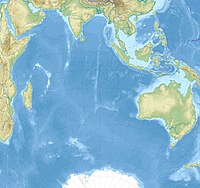
Photo from wikipedia
Using the boundary integral equation method with the slip-weakening friction law, we investigate the effects of the initial stress field and the critical slip-weakening distance on the rupture selectivity on… Click to show full abstract
Using the boundary integral equation method with the slip-weakening friction law, we investigate the effects of the initial stress field and the critical slip-weakening distance on the rupture selectivity on the 3D buried branched faults. The numerical results show that after reaching the bifurcation line between the main fault and the branched faults, rupture continues to propagate on one or both bifurcation planes (BPs), with rupture on one plane more favorable than the other. The initial stress distribution plays a decisive role in the selection of the favorable BP (FBP), and there is a critical status of stress distribution, around which rupture propagates on both planes, whereas the FBP switches between the two. For a given fault geometry, the critical status of initial stress, which is described by a ratio Fp between normal stresses, is related to the critical slip-weakening distance Dc.
Journal Title: Bulletin of the Seismological Society of America
Year Published: 2020
Link to full text (if available)
Share on Social Media: Sign Up to like & get
recommendations!